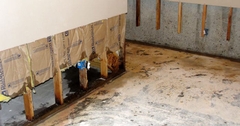Blog Post
Water Damage Tips – How to Fix Water Damaged Insulation

WET INSULATION – NOW WHAT? So many questions float around about what to do with water-damaged insulation? Water-damaged insulation is a breeding ground for mold which can be a health hazard to you and your family.
Ways to Detect Water Damaged Insulation
- A light layer of mold or discoloration my form on the walls or baseboards
- The drywall in that area may swell up and "nail pops" may appear; this is when the nail/screw is pulled through the paper layer of drywall
- An odor may become noticeable
- Wall coverings or paint my begin to peel or delaminate
Different Types of Insulation Require Different Treatments
There are many different types of insulation that are made of different products. Different products require different treatments. Some insulations are made of fiberglass, cellulose, foam board, or cotton spray foam. Some of these organic materials are perfect breeding homes for mold. It is imperative, that one immediately addresses ANY type of insulation damage as it can contribute to broken pipes, etc. MOREOVER, it is an indicator of larger issues!!! Something had to make it wet and it has to be addressed.
You Don't Always Have to Expose and Replace Insulation To Stop Mold
If you aren't sure if your insulation is saturated, one way to find out is to expose the insulation and replace it but sometimes water-damaged insulation can be dried out with proper tools and equipment. Contact a professional restoration company, they will have the appropriate tools, techniques, investigative knowledge to put together good data so the best decisions can be made prior to senselessly wasting hard earned cash!
Generally speaking… vertical insulation can be dried (depending on the type) whereas horizontally installed insulation has be removed. Finally, the plastic often found immediately adjacent to the drywall and on top of the insulation serves as a vapor barrier and is a classic catch 22. It keeps moisture in check under normal conditions but disallowed for the passage or moisture under conditions where drying is necessary.
A good restoration company can make sure damaged insulation is found and cleaned properly and that you're out of pocket damage liability is kept to a minimum. We've helped numerous home and business owners and they and their insurance company always appreciate our surgical approach to restoration!
